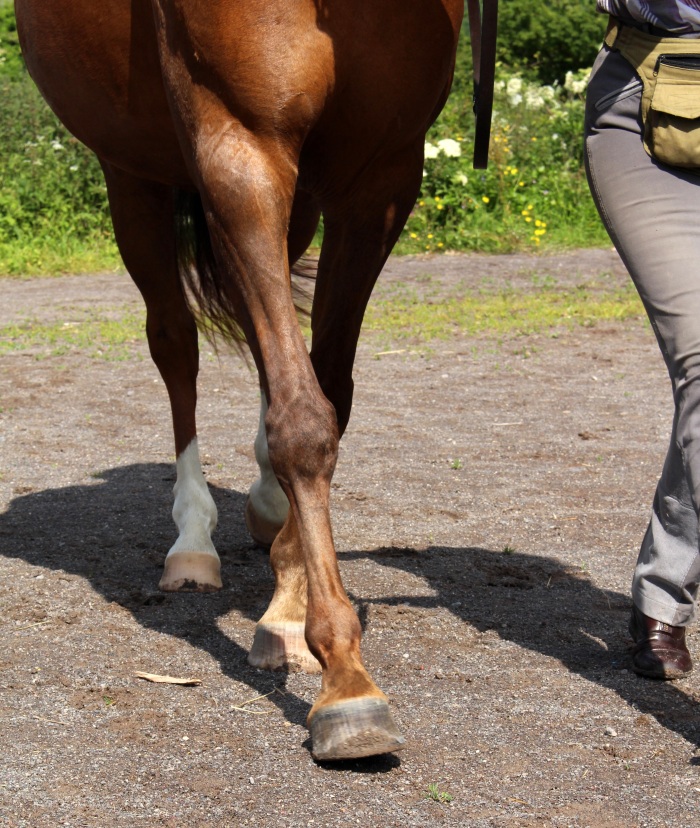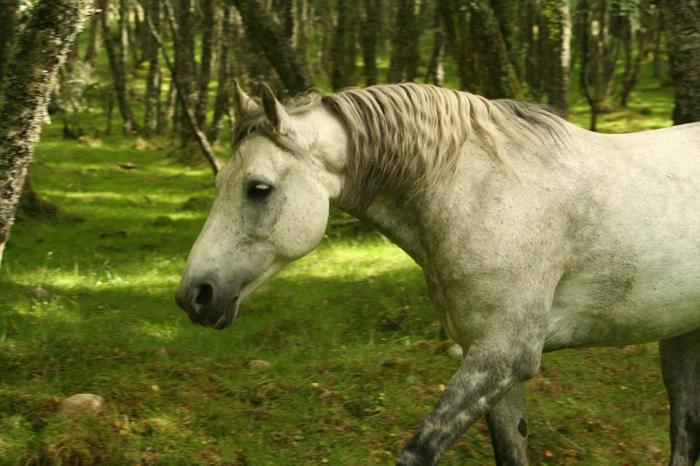When you hear about the idea of riding your horse barefoot, what is your biggest concern? Do you worry about their feet falling apart, bits falling off, or the dreaded ‘wearing away’? Let me tell you a secret from pro-trimmers – we NEVER worry about any of those things. Or hardly ever anyway. We might worry that you will be worried about them, and about how we can reassure you. Otherwise nope, they are not a significant problem on our check list.
The reason we don’t worry is because we have the whole rest of the horse to think about! One of my last shoes off clients is a case in point. Her carer has tried her barefoot before and her feet ‘fell apart’. Well obviously not completely, but the damaged, dried out, weakened horn around the nails crumbled and made the edges of the hoof wall look a bit horrible. The horse was moving fine, but she’s a big solid mare and her feet started to flare, and her last hoof care professional didn’t really do anything about it, so more bits broke off, and cracks appeared, and then they tried grooving above the cracks (that sounds funky…), and yada, yada, yada. You know the rest of it.
So now it was my turn to team manage the second go at barefootin’. Her carer carefully listed all the things that were on her mind (see above). While she related the story to me I wasn’t looking at the feet, I was ‘grooving above the cracks’ so to speak. I was looking at the rest of the horse. Like I say she was a big strong mare, she had a straight leg at each corner and a wardrobe in the middle, in regular work with a good biomechanical trainer, a managed diet and environment. All things being equal she should manage fine with some responsive hoofcare.
When a horse is barefoot, the condition, shape and resilience of the horse’s feet are absolutely, utterly and completely the product of what’s going on in the rest of the horse’s body. If say I spot flare in an assessment, I want to see what in the horse’s musculo skeletal balance is driving the initial deviation, and what else in terms of metabolic condition, weight, fitness etc is compounding the limb balance change.
Now before I go any further I want to let you into another pro-secret – the horse’s balance and hoof shape changes all the time. If you bring your horse in from the field, then leave them tied on a concrete yard for half an hour the shape of the hoof capsule will change. The horse is standing on a much harder surface than is was half an hour ago. If you then put them out again (we’re talking a fairly soft surface here, no hard baked dust pans) within half an hour the hoof wall will have visibly changed again. This is because the hoof is a smart structure. It responds to changes in the horse’s direct environment immediately.
I was once at a hoof care clinic where a group of pros were dumbfounded because a horse that had generated a long and detailed discussion of limb balance and possibly associated low level flare, was turned out in the arena over lunchtime, brought back in, and the flare had ‘disappeared’. As a reaction some hoof care professionals believe that we should ignore the existence of flares, or that the horse ‘needs’ long toes as some kind of support, or even that feet, and ligaments and tendons and nerves and bones, are not subject to the laws of physics including leverage. Far from it, the shape of the hoof is an outcome of the interaction between what is going on higher up and the exterior world. The shape of the hoof is also changing all the time, and in many, many cases is also change-able with biomechanical postural training and responsive hoof care (which is something hoof care pros, and coaches who were hoof care pros, love to see happen and what this post is really about).
I would like to introduce you to three important ways how riding and training can impact on your horse’s barefoot success. These are things holistic pros like me think about a lot:
- Functional symmetry
As humans we are drawn to the symmetry in faces and bodies. Some of us even get bothered when our environment is visibly lacking in symmetry. Findings show that if we are thinking about symmetry when we look at something, when it is visually symmetrical this spontaneously makes us feel better about it (Pecchinada et al 2014).
Functional symmetry is a mathematical concept, but it is also used in biomechanics to describe how the movement of the limbs on the right and left sides of the body compare. Let’s think about foot placement. If we were standing side on watching a horse walk or trot up in front of us, would one front foot land more or less heel first than the other? Can the horse step its left hind leg further away from its midline than the right hind under the same circumstances? What is the difference in where the horse chooses to place the foot and what might be influencing that?
As the rider or ground worker, our bodies influence the functional symmetry of how our horse moves. Working on our own functional symmetry is best done off horse, and using all the great tools we have these days, like mirrors for instance, we can become more aware of the symmetry (or assymmetry) of our posture.

Over time, we can develop the skills to change our posture which will change our horse’s way of carrying us or working with us on the ground. As a pro trainer and an old ex pro-trimmer I want to know that my clients have knowledgable eyes on their own and their horses bodies who are going to help them with functional symmetry and give them good skills. I also want to know that they have a realistic expectation of how much Time to Fix Things will be required. If they have a trainer who has zero real understanding of biomechanics you can tell in their bodies and feet, and their hoof care professional is never going to feel like they are winning.
2. Building healthy movement patterns
It is normal for healthy barefoot horses walked and trotted up in hand, or moving around in a relaxed attitude, to place the feet visibly heel first. In these circumstances the muscle tone in the rest of the horse’s body is often low, it is in an efficient neutral posture, and it is not required to carry a rider’s weight. Horses that do not land heel first when walked or trotted up in hand but still have a relaxed posture either have a pathology somewhere in the body that is causing them pain, or have weakly developed feet. As horses are commonly observed by hoof care professionals walked or trotted up in hand, and we like calm relaxed horses, heel-first landing is what we commonly expect to see, but like lots of things more is not necessarily better.

When a horse is trained to change it’s posture during collected ridden work, as in good classical dressage training, its stride length becomes more dynamic – moving between higher and shorter steps to longer, more ground covering steps. The fascial net of its body in collected work holds more spring, more potential and its landings change. In collected steps flat or even toe first landings can happen, but the effect is mitigated by the slow speed, control and trained tone of the horse’s body.
It is really important for the horse’s body and feet that they are trained to learn the best posture for the ‘carrying’ part of being ridden, otherwise we put them at risk of horrible pathologies like arthritis and kissing spines. Correct biomechanical training can substantially increase the control a horse exerts over its limb movement, and is how we build healthy movement patterns. [Thankyou Dorothy Marks and Solo for demonstrating a ‘tensegrity’ trot].

3. Making good posture feel good
Yesterday in my first schooling session after the snow with the Ladster we started the same way as usual, establishing that he was calm and happy to leave the herd and spend some time with me doing gymnastics. He had eaten a feed, had a big warm drink, had some hay while we tacked up, then we walked slowly across the big field together checking out the condition of the ground and whether there were vole and rabbit holes anywhere I was planning to ride. We did lots of copycat blowing, and the atmosphere was definitely ‘amble in the park’ before I mounted. See my blog post Adventures in trust & connection – having the horse’s back for why setting up the right attitude helps.
My aim in training is to layer ‘good’ experiences, only adding more challenging ones if bracketed by definite ‘good’ associations and to be LIMA – Least Invasive & Minimally Aversive. The day’s progression was to find even bend in my body so he could take it up, and to explore what happens in moving frequently between higher and extended neck position in trot for him, on both reins. Lad has experienced a more balanced posture in the last few years which has given me access to a major movement reward. I don’t have to mark and stop to reward good posture with food, he chooses to carry it on sometimes after I suggest we could stop, or when I turn him out back to the herd.

Neck extension with tensegrity was so different to his prior posture, those early FDO experiences must have felt incredible. It might have been impossible to get the timing wrong because the movement, like a good stretch, was an intrinsic reward. Now he returns to it very easily with huge enthusiasm.
So tell me – what is in the front of your mind now when you think about your newly barefoot horse, or your barefoot from birth youngster?
Some of this article was shared from my book Barefoot Horse Keeping – The integrated horse. I hope you have enjoyed this post, you can find a link to the book here.
For more information about my work, visit my website at www.annistonebridge.com
References
